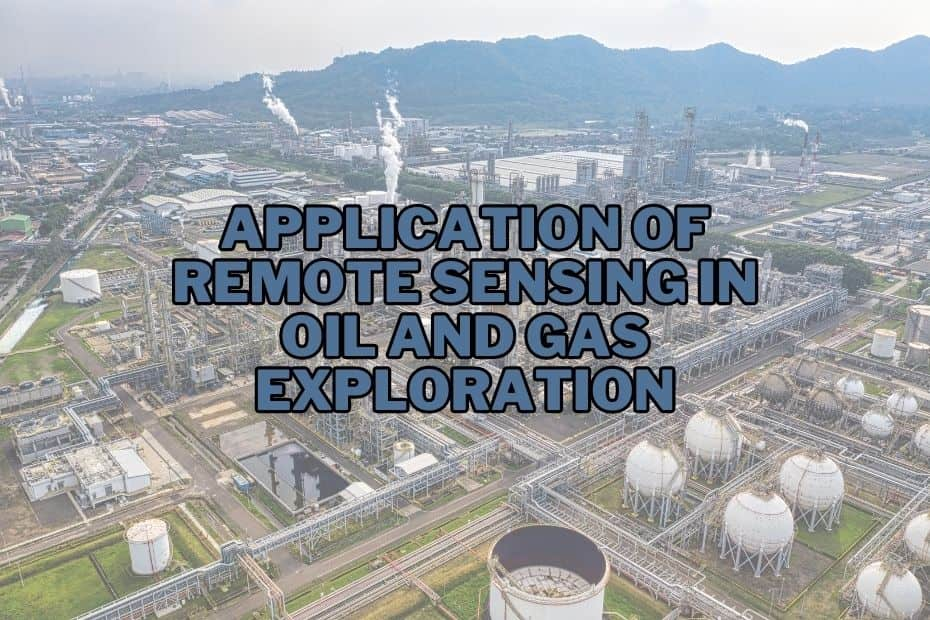In the realm of oil and gas exploration, remote sensing has emerged as a game-changer, offering a wide array of applications that streamline processes, enhance efficiency, and promote environmental responsibility. In this comprehensive guide, we’ll delve into the crucial application of remote sensing in oil and gas exploration that are shaping the industry’s future.
Remote sensing enables efficient identification of subsurface geological structures, hydrocarbon indicators, and potential drilling sites. This technology aids in minimizing exploration risks, optimizing resource allocation, and enhancing overall decision-making processes within the industry.
Application of Remote Sensing In Oil and Gas Exploration
Do you know how oil and gas companies find their next big reservoir? It’s a lot more sophisticated than just digging a hole and hoping for the best. One of the key technologies that’s transformed the industry is remote sensing.
1. Surface Feature Analysis
Remote sensing facilitates detailed surface feature analysis, offering a comprehensive understanding of the terrain. Satellite imagery and aerial surveys provide high-resolution data, aiding in the identification of potential drilling sites, access routes, and infrastructure placement. This data-driven approach minimizes the risk associated with site selection, ensuring optimal utilization of resources while preserving delicate ecosystems.
2. Mapping and Monitoring Pipeline Infrastructure
Efficient transportation of extracted resources relies on a well-maintained pipeline network. Remote sensing enables real-time mapping and monitoring of pipeline infrastructure, detecting potential leaks, corrosion, or encroachments. Continuous surveillance enhances maintenance accuracy, mitigating the risk of accidents and ensuring seamless operations.
3. Identifying Oil Spills
Oil spills pose significant environmental and economic threats. Remote sensing, with its ability to swiftly detect and assess spills, aids in rapid response and containment efforts. By analyzing spectral signatures, infrared imagery, and radar data, the technology assists in estimating spill extent, minimizing ecological harm.
4. Seismic Interpretation
Accurate seismic data interpretation is paramount in locating subsurface oil and gas reserves. Remote sensing, when integrated with seismic surveys, enhances the precision of identifying potential reservoirs. By analyzing reflected signals, this approach provides insights into subsurface structures, enabling informed decision-making.
5. Evaluating Geological Structures
Remote sensing complements traditional geological studies by offering a macroscopic view of the Earth’s surface. This aids geologists in identifying geological structures that could potentially harbor hydrocarbons. Integration of multispectral and hyperspectral data refines lithological and mineralogical mapping, improving resource assessment.
6. Temperature and Pressure Monitoring
Maintaining optimal temperature and pressure conditions is crucial in oil and gas extraction and processing. Remote sensing systems equipped with thermal sensors enable continuous monitoring of equipment, ensuring operational efficiency and preventing costly breakdowns.
7. Groundwater Studies
Oil and gas operations can impact groundwater quality. Remote sensing aids in monitoring groundwater levels and detecting contamination through spectral analysis. This information supports sustainable practices and prevents adverse environmental effects.
8. Environmental Impact Assessment
The remote sensing technology assists in conducting comprehensive environmental impact assessments. By comparing pre- and post-exploration imagery, it facilitates the evaluation of ecological changes, aiding in compliance with regulations and minimizing ecological disruptions.
9. Hazard Analysis
Oil and gas exploration zones often intersect with areas prone to natural hazards. Remote sensing identifies potential risks, including landslides, subsidence, and seismic activity. This information enhances operational safety and reduces vulnerability.
10. Exploration of New Reservoirs
Identifying untapped reservoirs is a perpetual challenge. Remote sensing offers a cost-effective solution by providing insights into subtle surface variations indicative of subsurface hydrocarbons. This expedites exploration and minimizes resource wastage.
11. Asset Management
Effective asset management is essential for sustained operations. Remote sensing aids in monitoring asset conditions, predicting equipment failures, and optimizing maintenance schedules. This proactive approach enhances operational efficiency and cost-effectiveness.
12. Climate Impact Analysis
Oil and gas activities can influence local climates. Remote sensing enables monitoring of greenhouse gas emissions and thermal anomalies. Such analysis facilitates compliance with environmental norms and encourages sustainable practices.
Conclusion:
In conclusion, remote sensing has revolutionized the oil and gas exploration industry, providing invaluable insights that streamline processes, minimize risks, and reduce environmental impact. Its multifaceted applications, from mapping pipelines to identifying spills and evaluating geological structures, underscore its significance in modern exploration efforts. By harnessing the power of remote sensing, the oil and gas industry can achieve greater efficiency, precision, and sustainability in its operations.
FAQs: Application of Remote Sensing In Oil and Gas Exploration
What is the primary purpose of remote sensing in the oil and gas industry?
The primary purpose is to aid in exploration, monitor assets, and ensure environmental sustainability.
Can remote sensing predict oil spills?
While it can’t predict spills, it can quickly detect them, aiding in swift response and recovery efforts.
Can remote sensing guarantee the presence of oil and gas?
While it offers clues and data, drilling is the definitive way to confirm the presence of oil and gas reserves.
How does vegetation indicate the presence of hydrocarbons?
Certain patterns in vegetation can signify hydrocarbon micro-seepages, which might indicate underground reserves.
